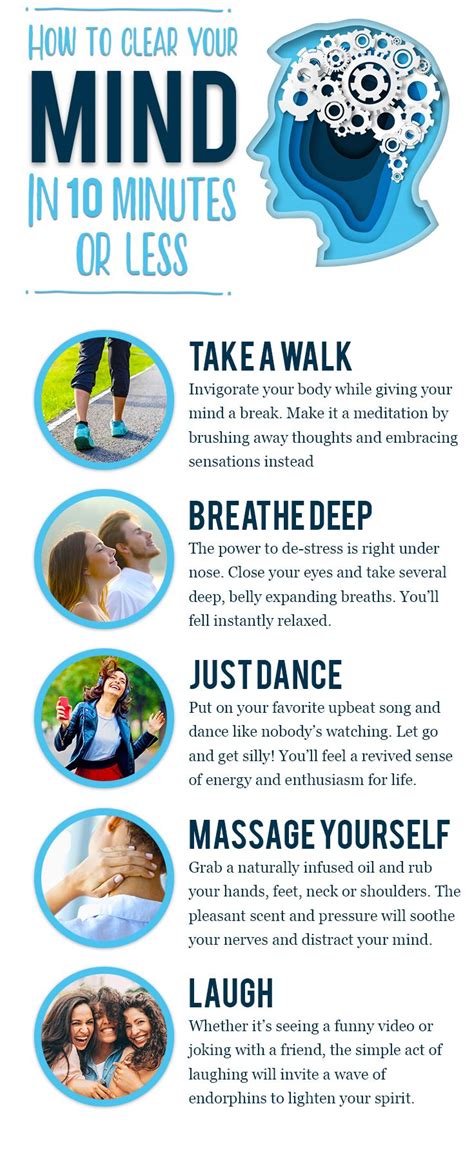How to Clear Your Mind: Techniques for Mental Clarity and Focus
Feeling overwhelmed? A cluttered mind can lead to stress, anxiety, and decreased productivity. Learning how to clear your mind is a valuable skill for improving your overall well-being and achieving your goals. This guide provides practical techniques to help you achieve mental clarity and focus.
Understanding a Cluttered Mind
Before diving into solutions, it's crucial to understand why your mind feels cluttered. Common culprits include:
- Information Overload: Constant exposure to news, social media, and work demands can overwhelm your brain's processing capacity.
- Unresolved Issues: Lingering worries, anxieties, and unresolved conflicts consume mental energy.
- Lack of Structure: A disorganized schedule and lack of clear priorities contribute to mental chaos.
- Poor Sleep: Insufficient or poor-quality sleep impairs cognitive function and increases mental clutter.
Effective Techniques to Clear Your Mind
Now, let's explore proven methods to quiet the mental noise and achieve a clearer state of mind:
1. Mindfulness and Meditation
Mindfulness involves paying attention to the present moment without judgment. Even a few minutes of mindful breathing can significantly reduce mental clutter. Focus on your breath, noticing the sensation of the air entering and leaving your body.
Meditation takes mindfulness a step further, often incorporating guided visualizations or mantras to promote relaxation and mental clarity. Numerous apps offer guided meditations for beginners.
2. Physical Activity
Exercise is a powerful tool for stress reduction and mental clarity. Physical activity releases endorphins, which have mood-boosting effects. A brisk walk, a yoga session, or a workout at the gym can significantly improve your mental state.
3. Spending Time in Nature
Nature has a calming effect on the mind. Spending time outdoors, whether it's a walk in the park or a hike in the mountains, can help reduce stress and improve focus. The sights, sounds, and smells of nature offer a welcome respite from the demands of daily life.
4. Journaling
Writing down your thoughts and feelings can help you process them and reduce mental clutter. Journaling doesn't have to be elaborate; simply jotting down your thoughts can provide relief and clarity. Consider using a gratitude journal to focus on the positive aspects of your life.
5. Digital Detox
Our constant connection to technology contributes significantly to mental overload. Taking regular breaks from screens – phones, computers, and tablets – allows your mind to rest and recharge. Consider scheduling specific "digital detox" periods throughout the day.
6. Prioritize and Organize
A cluttered environment often mirrors a cluttered mind. Organize your workspace, your home, and even your digital files. Prioritizing tasks helps you focus on what's truly important, reducing feelings of overwhelm. Utilize to-do lists and scheduling tools to manage your time effectively.
7. Get Enough Sleep
Aim for 7-9 hours of quality sleep each night. Sufficient sleep is essential for cognitive function and emotional regulation. Establish a consistent sleep schedule and create a relaxing bedtime routine to improve the quality of your sleep.
8. Practice Saying No
Overcommitting yourself leads to stress and mental overload. Learn to politely decline requests that stretch you too thin. Protecting your time and energy is crucial for maintaining mental clarity.
Maintaining a Clear Mind: Long-Term Strategies
Clearing your mind is not a one-time event; it's an ongoing process. Incorporate these strategies into your daily routine to cultivate a clearer, more focused mind:
- Regular Mindfulness Practice: Even short daily sessions can make a difference.
- Consistent Exercise: Make physical activity a non-negotiable part of your schedule.
- Prioritize Self-Care: Make time for activities that nourish your mind and body.
By implementing these techniques, you can effectively clear your mind, reduce stress, and improve your overall well-being. Remember, consistency is key. Start with one or two techniques and gradually incorporate more as you develop a routine that works for you.
